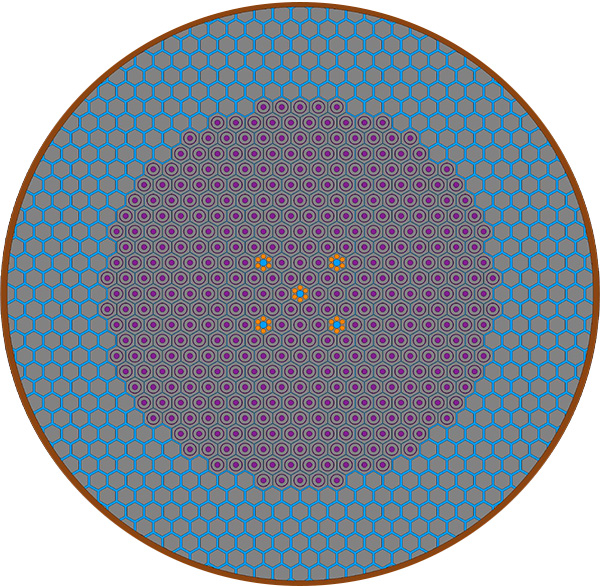
MSiBR Reactor radial slice view. Caption (including names): Radial (top-down) view of the new MSiBR model. The control rods (yellow and blue) can be inserted to slow the rate of uranium fission, which occurs in the fuel region (purple). The outer reflection network (blue) returns stray neutrons back into the center of the reactor.
The unassuming rocks surrounding mines could soon be powering cities.
“Thorium is everywhere when you mine rare earth metals. It is a waste product of that process,” said Research Assistant Professor Ondřej Chvála. “But it can be burned for energy.”
Molten salt reactors (MSRs) fueled by thorium were the topic of considerable research at ORNL in the 1960s, but government funding changed focus in the 1970s. Now, with funding from Flibe Energy and the Electric Power Research Institute, Chvála and his students hope to bring thorium energy back into the limelight. Their model has been accepted to the Annals of Nuclear Energy, a top nuclear science journal, and will be published in November 2022.

Erika Moss
“A thorium-232 atom is not fissile on its own,” said Erika Moss, a nuclear engineering student at UT and the lead author on the paper. “However, when it captures a neutron, it turns into uranium-233—a material capable of sustaining a nuclear fission chain reaction. This allows us to create sufficient quantities of nuclear fuel from non-fuel materials.”
“Burning standard uranium creates mixed radioactive waste that is expensive to process and is dangerous for thousands of years,” Chvála said. “But uranium-233’s reaction chain only generates one actinide ‘waste’ product, plutonium-238, which is a valuable fuel for generators used in space probes.”
Moss’s work models a molten salt iso-breeding reactor (MSiBR) in which two types of salt flow through the core.
“In a single-fluid thorium reactor, the thorium and uranium are in the same salt,” said Chvála. “In this two-fluid system, they are separate. We bubble fluorine gas through the thorium salt, capturing the uranium so it can be moved to the fuel salt loop. This separation makes fuel reprocessing simpler and less expensive.”
Since the fuel salt is in a separate loop, the reactor can be refueled while it’s operating, providing uninterrupted power.
That also makes it possible to add in fuel from other sources—including fuel that can no longer sustain fission in other types of reactors.
“The MSiBR system can take used fuel from stockpiles nationwide and turn it into usable energy,” said Moss.
However, the separate fuel stream also makes the MSiBR more difficult to model. The team needed to develop a new code framework to predict the core’s nuclear behavior as the two salts flow through the reactor.
“This paper’s framework makes it easier to design molten salt systems,” Chvála said. “Now, if someone has funding to do this research, they can grab our tools and run with them.”
The team hopes that their model inspires further research and use of two-salt thorium reactors.
“What a truly amazing technology this is,” said Moss. “It can deliver carbon-free, reliable power while recycling used fuel from other reactors. MSRs give new purpose to materials which would otherwise be wasted, using them instead to energize our world safely, clearly, and efficiently.”